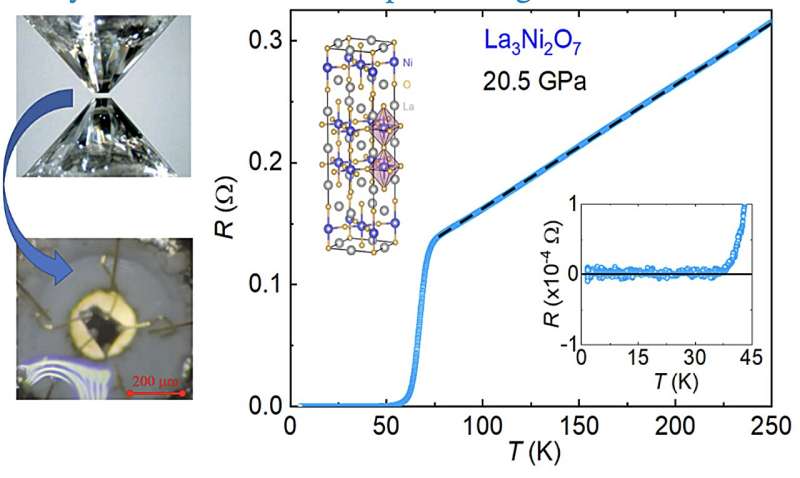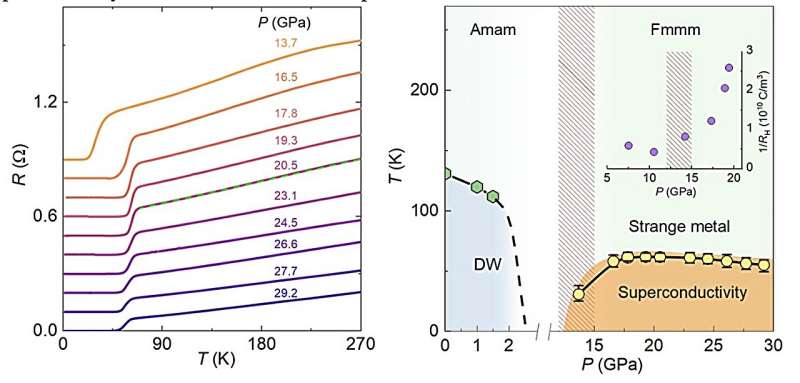June 25, 2024 feature
This article has been reviewed according to Science X's editorial process and policies. Editors have highlighted the following attributes while ensuring the content's credibility:
fact-checked
peer-reviewed publication
trusted source
proofread
A high-temperature superconductor with zero resistance that exhibits strange metal behavior

Researchers at Zhejiang University and Sun Yat-Sen University have gathered evidence of high-temperature superconductivity with zero resistance and strange metal behavior in a material identified in their previous studies.
Their findings, published in Nature Physics, highlight the promise of this material to study these rare physical properties and ultimately leverage them to develop innovative electronic devices.
"High-temperature superconductivity is one of the most intriguing puzzles in the field of condensed matter physics," Prof Huiqiu Yuan, the project leader for this work, told Phys.org.
"It holds the potential to revolutionize technology by enabling the creation of superconducting electronics cooled by liquid nitrogen (above -195.8 °C or 77.4 K). Consequently, the pursuit of superconductors with high transition temperatures and the understanding of their mechanisms are among the most compelling objectives in condensed matter physics."
High-temperature superconductors are highly sought after materials, as they could aid the development of a new class of electronics. As a result, any indications of high-temperature superconductivity often attract significant attention, both from researchers and electronics companies.
In 2023, a research team at Sun Yat-Sen University led by Prof Meng Weng reported signatures of superconductivity at temperatures below 80 K in La3Ni2O7, a bulk-nickelate material. As 80 K is above the boiling point of liquid nitrogen, this discovery in itself was a breakthrough, yet it also came with some limitations.
"A significant drawback in the initial discovery by Prof Wang was the absence of zero resistance, the most distinctive characteristic of a superconductor," Prof Yuan said.
"While a main challenge is that high-temperature superconductivity in this material is only observed when subjected to a pressure of at least 14 gigapascals (nearly 140,000 atmospheres). Therefore, high-precision measurements and specialized high-pressure devices are essential for further investigations."
To examine La3Ni2O7 further, the researchers at Sun Yat-Sen University teamed up with Prof. Yuan's group at Zhejuang University's Center for Correlated Matter (CCM), which specializes in the study of strongly correlated materials under extreme conditions.
Prof. Yuan recognized that the absence of zero resistance in Prof Wang's initial report could be attributed to the inhomogeneities of the sample itself, as well as pressure conditions caused by the solid pressure medium of KBr powder.
The researchers thus set out to carry out a new study investigating the material's properties using a new sample and different pressure conditions. Specifically, Prof Yuan proposed using tiny samples and better hydrostatic pressure conditions, as these elements could represent the key to observing zero resistance.
"Coincidentally, our team recently improved the high-pressure technique, by applying a liquid pressure medium in a diamond anvil cell, suitable for creating homogeneous (hydrostatic) pressure, and making electrical contacts on a tiny sample of 100mm length using silver paste," Prof Lin Jiao, one of the co-corresponding authors of the paper and a faculty member at the Center for Correlated Matter, explained.
"Upon measuring the electrical resistance of La3Ni2O7 at high pressures using this method, we observed a sharp drop in resistance when cooled below 66 K, indicating the onset of superconductivity."
The researchers cooled the material down further and found that its resistance reached zero below 40 K. Their experiment thus gathered evidence that La3Ni2O7 exhibits high-temperature superconductivity under pressure. Following the release of their paper, the scientists have become confident that La3Ni2O7 is truly a high-temperature superconductor.
"The primary challenge in studying La3Ni2O7 lies in its meta-stable chemical composition," Prof. Yuan said.
"This leads to the expectation of numerous crystal defects, phase boundaries, interfaces, and coexistence of different compositions within La3Ni2O7 even in micrometer scale. To address these issues, tiny single crystals (approximately 100*100*20 micrometers) were measured, and quasi-hydrostatic pressure was applied as previously mentioned."

Essentially, Prof Yuan and his colleagues placed a small piece of a single crystal of the material between the anvils of two diamonds, filling the gasket embedded in these anvil faces with a liquid medium. They glued four to five Au wires, each of which was approximately 15 micrometers in thickness, on the surface of the sample using silver paste, to ensure good electrical contact.
The researchers subsequently applied high pressure to the sample, which compressed it, and then cooled it down to a few kelvins. By measuring the sample's resistance in conjunction with the temperature and pressure it was at, they demonstrated its zero-resistance.
"Our most significant and noteworthy discovery is that the resistance of La3Ni2O7 begins to drop sharply upon cooling below 66 K and reaches zero around 40 K," Prof Yuan said. "This experiment provides crucial and convincing evidence that La3Ni2O7 is a high-temperature superconductor, joining the ranks of unconventional high-temperature superconductors alongside cuprates and iron-pnictides."
In addition to gathering evidence of high-temperature superconductivity with zero resistance in La3Ni2O7, this recent study offers insight into the physics underlying this state. In fact, the researchers observed clear strange metal behavior in their sample under pressure, unveiling a link between this behavior and superconductivity.
"The term 'strange metal' refers to materials, most of which exhibit unconventional superconductivity and/or a zero-temperature quantum phase transition upon tuning by a non-thermal parameter, that cannot be described by our existing knowledge based on Landau's theorem," Prof Yuan said.
"This suggests a departure from the conventional behavior of charge carriers, which no longer seem to simply act as electrons. A typical feature of strange metals, as we observed in La3Ni2O7, is a linear resistance versus temperature (T-linear resistance)."
As La3Ni2O7 exhibits strange metal behavior, the mechanism underlying its superconductivity should be drastically different from that described by the Bardeen-Cooper-Schrieffer (BCS) theory, which explains typical superconductivity of simple metals and alloys. Prof Yuan and his colleagues believe that their findings could also apply to other unconventional superconductors presenting strange metal behavior.
"We also found that the inverse Hall coefficient undergoes a pronounced increase while crossing the pressure-induced structural phase transition, suggesting that the modification of the electronic structure in the high-pressure phase is crucial for the appearance of superconductivity," Prof Yuan said.
This recent study by Prof Yuan, Prof Weng and their respective teams opens new interesting opportunities for the study of high-temperature superconductivity and its application in electronics. The researchers plan to continue probing the physics of La3Ni2O7, while also examining other unconventional superconductors.
"Our understanding of this new family of high-temperature superconductors is still in its early stages, and there is much work to be done," Prof Yuan said. "As demonstrated in this and other studies, superconductivity in nickelates appears to be extremely sensitive to atomic composition, particularly when there are deficiencies in the number of oxygen atoms."
Observed similarities between the superconductivity of different nickelates and that of other reported families of high-temperature superconductors hint at the possibility that nickelates could also be superconductors at high temperatures, yet potentially without requiring high pressures.
In their next studies, the researchers plan to identify more suitable candidate compounds, which could allow them to uncover the key ingredients for superconductivity in terms of chemical composition and crystal structure.
"We [have] been improving the sample quality of La3Ni2O7 and searching for other related materials, as this would allow to perform more measurements, including the order parameter, the relation between superconductivity and structural phase transition, and so on," Prof Meng Wang said.
"Recently, evidence of superconductivity in other nickelate compounds, such as La4Ni3O10, has been found. This not only expands the family of nickelate superconductors but also provides a relatively stable compound for in-depth study. However, improving the sample quality and reducing the pressure required for the superconducting transition remains a priority."
More information: Yanan Zhang et al, High-temperature superconductivity with zero resistance and strange-metal behaviour in La3Ni2O7−δ, Nature Physics (2024). DOI: 10.1038/s41567-024-02515-y.
Journal information: Nature Physics
© 2024 Science X Network




















